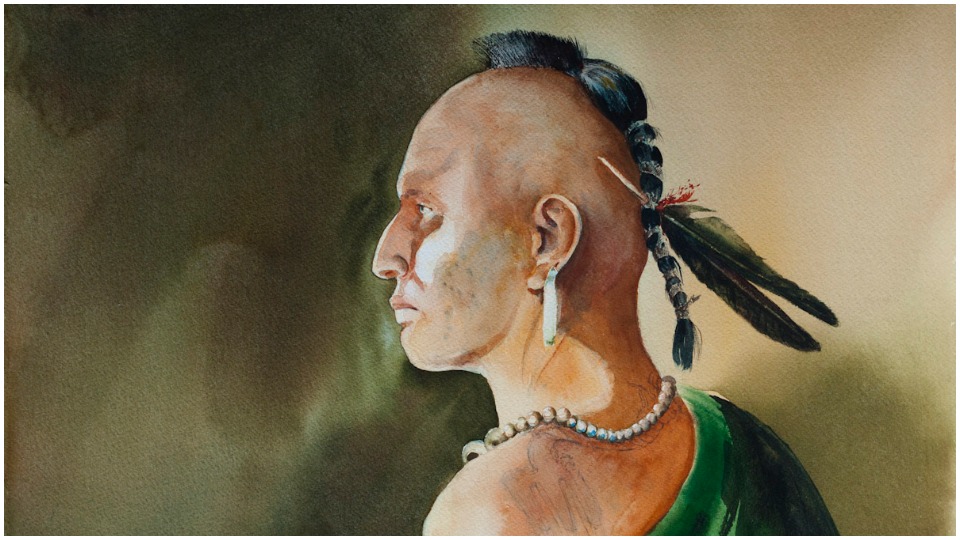
In the midst of downtown Nashville on a bright Sunday afternoon, an audience of several dozen at the Tennessee State Museum was reminded that the Cherokee war chief, the redoubtable Dragging Canoe, fought battles on the very ground they were standing on. In fact, Dragging Canoe was the leader of a massive Cherokee war company (over 1,000 warriors) that fought the Battle of the Bluffs in April 1781 that nearly wiped out Fort Nashborough, the founding settlement of Nashville. That battle was fought only a few blocks from the museum. Speculation is that if Dragging Canoe had lived past 1792 there would have been no Nashville.
The occasion was a lively panel discussion held on Sept. 29 on the great Cherokee leader organized by the locally-based American Indian Coalition (AIC). The panelists were Mark Tolley, chairperson of the Tennessee Ancient Sites Conservancy (TASC); Becky Hobbs, Cherokee Nation citizen, singer, songwriter, composer, direct descendant of Cherokee historical figure Nancy Ward, and writer and producer of the musical Naneyehi: The Story of Nancy Ward; Toye Heape, a member of the Tennessee Historical Commission and the Alliance for Native American Rights and vice president of the Native History Association; and Nick Fielder, retired Tennessee state archaeologist and curator of the Tennessee State Museum. The panel discussion was moderated by Albert Bender, chairperson of the AIC.
Jeff Sellers, the Director of Education and Community Engagement for the museum, introduced the moderator and panelists. The discussion began with a presentation by Tolley, who divulged that the first white settlers in the area that became Nashville, the founders of Fort Nashborough, established the fort on the south side of the Cumberland River in violation of treaty provisions with the Cherokee Nation.
Hobbs spoke of the role played by her ancestor, Nanyehi, known also by her English name of Nancy Ward, who tried to maintain peace between Cherokees and white settlers during this turbulent period of the late 18th century. Hobbs also mentioned that under treaties, the Cherokee Nation has the right to send a representative to the U.S. Congress. Currently, it is exercising that right by sending tribal citizen Kimberly Teehee, who is also a Nancy Ward descendant, to Congress.
Heape told of the 1775 Treaty of Sycamore Shoals, also known as the Transylvania Purchase, in which the Cherokee Nation purportedly sold Kentucky and Middle Tennessee for white settlement. Heape said that Dragging Canoe vehemently opposed the Treaty and prophesied that the settlement of those lands by the incoming Europeans would be “dark and bloody,” thus presaging the beginning of the long and bloody Cherokee War.
Heape illustrated the contacts between Cherokees and whites in this warring, tumultuous era. He contended that the Battle of the Bluffs was a victory for Dragging Canoe and spoke of the falsification of history by later white historians, such as the tale of how Cherokee warriors were driven off by the dogs of the settlers during the battle. This account has been credibly debunked, according to Heape. He advanced the argument that Dragging Canoe organized the “strongest Native resistance movement in U.S. history.”
Fielder brought to light the fact that the 1761 British emissary to the Cherokee Nation, Henry Timberlake, was, in reality, a spy. Timberlake is best known for his account of journeying to the Nation to promote bonds of peace following the Cherokee-British War of 1760-61. He became a source of information on 18th century Cherokee culture and wrote a book of memoirs describing his journey. According to Fielder, he was also a spy to provide information on the location of Cherokee towns and military strength of the Nation.
It was also revealed that much of the history of the Cherokee War as written by white historians in the early in the 1920s and ’30s falsified the past. Particularly in the 1930s, accounts were written and historical markers erected claiming settler victories over Cherokee forces. This was done in a sordid attempt to attract tourists to Tennessee during the Great Depression era—an attempt to pull in tourism dollars to bolster the declining state economy. In fact, in at least one instance, a claimed battle never even took place.
Also debunked was the claim that Dragging Canoe only “led a disaffected band of Cherokee against colonists and United States settlers.” Dragging Canoe, in fact, led the vast majority of the Cherokee Nation to relocate to southeastern Tennessee and adjacent areas to continue the war against the invading colonists. He additionally dispatched Cherokee war companies to areas of the North and Midwest to aid other Native nations who were also resisting the settler onslaught.
The panelists’ presentations were followed by an enthusiastic question and answer session. The gathering ended with all feeling very enriched in learning of the life and the resistance of a great Indigenous hero.












Comments